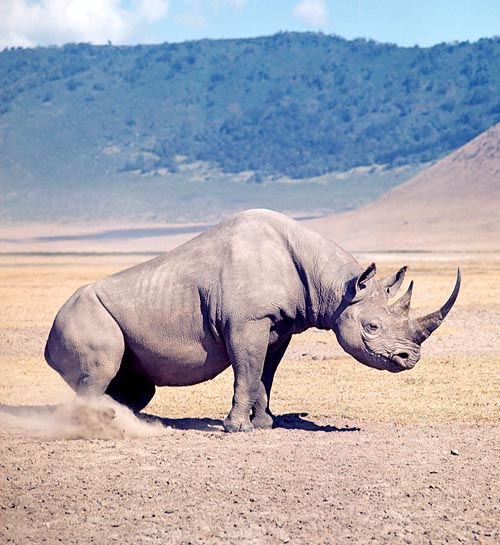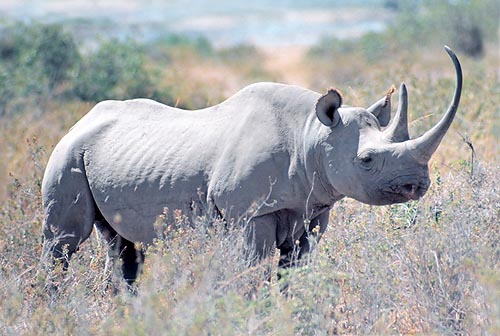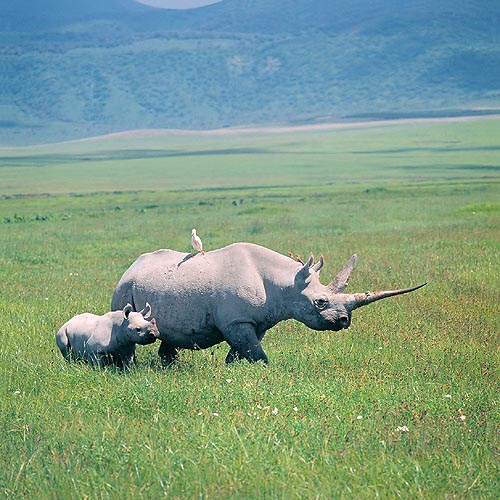Family : Rhinocerontidae

Text © DrSc Giuliano Russini – Biologist Zoologist

English translation by Mario Beltramini

Getting up is not easy when you weigh two tons © Giuseppe Mazza
Diceros bicornis Linneus, 1758, order Perissodactyla.
The etymology of the word Rhinoceros has both Latin and Greek derivation, (from the Latin “Rinoceros-ontis” and from the Greek “Rinokeros”, comparative of “rhis-rhinos” = nose and “keras”= horn).
They are four-footed mammals, placentated (Eutheria), Homothermal-Endothermal (Endothermal: from the Greek “endon”= inside, “thermόs”= heat; Homothermal: from the Greek “omos”= same, “thermόs”: heat) which, like all warm-blooded animals (the warm-blooded animals belong to the Classes of the Mammals and the Birds, whilst the cold-blooded animals belong to the Classes of the Reptilians, Amphibians and Fish defined as Ectothermic, from the Greek ektos: outside, thermos: heat), human being included, have a constant value of the inner temperature, independently from the local one and have the capacity to control it and keep it as such between specific limits of local variation, exploiting most of the energy obtained from the oxidation of the nourishing substances assimilated through the aliments; for instance, increasing the metabolic rate.
The ancestor from which the Rhinoceroses most probably come more directly is the Woolly Rhinoceros (Coelodonta antiquitatis) a genus of rhinoceros with a coat of thick black and dark brown wool living in all Eurasia during the Pleistocene, during the glacial age. Fossil skeletons have been found in Russia. During such geological period and for thousands of years, the Rhinoceros had a distribution at high radiation, as it lived, not only in the African and Asiatic continents, as is the case today, but also all over Europe. The proof stands in the huge quantity of fossil skeletons found in Italy, France, Spain, England, Germany, etc.
Moreover, many specimens of the present Afro-Asian Fauna, such as Panthera leo, Panthera tigris, Panthera pardus and Rhinoceroses of the genus Ceratotherium, Diceros, and Hippopotamus amphibius, were probably the remains of species living in situ, before the formation of the continents and their separation due to the continental drift. For instance, in the Early Pleistocene, little more than 2,5 million of years ago, first period of the Quaternary period, corresponding to the Lower Palaeolithic, where the Homo habilis and the Homo erectus were going around, in Figline-Valdarno, San Giovanni Montevarchi and even more towards Arezzo and the Val di Chiena, were living stocky mastodontic pachyderms, of which they have found more or less complete skeletons.
Among these ones, the oldest proboscideans ever found, were the Mastodons (Anancus arvenensis), whose dimensions corresponded to those of the present Asian Elephant (Elephas maximus), even if stockier and more robust. The southern Elephant (Elephas meridionalis), always from the Pleistocene, was found between Montevarchi and Rignano. Fossil remains of the Woolly Rhinoceros (Coelodonta antiquitatis) and of Hippopotamus major, have been found by the paleontologists in the eighties of the XX century, close to Arezzo. In our case, the Rhinoceroses, like all other members of the Order of the Perissodactyls and the Artiodactyls, as herbivores (primary consumers in the food chain), as nourishing of aliments rich of fibres with low energetic contents, must eat more frequently than the secondary and tertiary consumers (carnivores), eating enormous quantities of food, often, on a daily basis, equal to the 30% of their body weight. For such reason, they are defined by the ecologists, as “energy conservators”, the same being mostly spent for keeping constant the value of the inner temperature, between specific limits of variation of the outer one. The Rhinoceroses are the four-footed terrestrial species, together with the Elephants (Loxodonta africana, African species, Elephas maximus , Indian one), and the Hippopotamuses (Hippopotamus amphibious), of major dimensions and weight. For such reason, they are called Pachyderms (from the Latin Pachidérmus, from the Greek pachys: big, thick, fat and dérma: skin). In Africa there are presently two species with two horns, the Ceratotherium simum of Burchell, called great two-horns White Rhinoceros and the Diceros bicornis Linnaeus, 1758, called Black Rhinoceros and three one-horn species endemic of Asia (India, Java Island, Sumatra), which are the Dicerorhinus sumatrensis , called also Hairy-coat Rhinoceros, the Rhinoceros sondaicus, called also Javan Rhinoceros, and the Rhinoceros unicornis, called also Indian Rhinoceros, which is the biggest of the three Asiatic species.
All species, both African and Asiatic, are in serious danger of extinction as the International Union for Control Nature (IUCN), the Convention of International Trade of Endangered Species (CITES) and the World Wildlife Fund (WWF) are seriously remarking, due to still existing stupid phenomena of poaching, to which it has added, always owing to the humans action, an intense deforestation of the ecosystems (biotopes and biomes) where these animals do live, for obtaining agricultural lands and to effect excavations for the extraction of valuable minerals. In particular, during the sixties and seventies, the two African species and the Asiatic one, the Rhinoceros unicornis, have been subjected to real carnages by the poachers, due to the stupid belief that the macerated horn should have energetic and aphrodisiac properties in the Eastern Medicine. The Biologists of the African and Asiatic reserves, who, in spite of the cooperation of the local Rangers, were unable to demolish the poaching and to increment the repopulation of the species, found then a stratagem. The method was consisting in cutting the long horn, formed by keratin fibres with a continuous growth, the only one utilized for the commerce, in such a way that these animals were not having any more interest.

Like a small trunk, the upper lip tears off leaves and twigs © Giuseppe Mazza
The five species, which have rather evident differences of dimension and of morphology, share an enormous mass and the presence of continuously growing horns, even if in different number and dimensions. They are formed by keratinous fibres, are not full of bone like the bovines, and lay on a bony plate. The vital biotic space (what is called Home-Range in Ecology), specific for each rhinoceros, representing the room they need for living in a suitable psycho-physic condition, followed by the capacity of reproduction, is determined by several parameters: the availability of food, sources of water for drinking and guaranteeing the baths in the mud.
These ones are of use, mainly for the African species, for lowering the body temperature during the day and eliminate the ectoparasite hematophagous insects present on their skin, as it happens for the African Buffaloes (Syncerus caffer), the Indonesian Water Buffaloes (Bubalus bubalis), the Anoa (Bubalus depressicornis) of the Anoa Islands, various species of Zebras, Gazelles, Giraffes and the Hippopotamus amphibious. Insects sucking the blood of the animal and creating, through their various vital cycles, infected cysts on the skin of the host. But the best solution to this problem is represented by the Oxpeckers, birds belonging to the genus Buphagus (Buphagus africanus and Buphagus erythrorhynchus, called also tickbirds) and to the Bubulcus ibis, called Cattle Egret, belonging to the family of the Ardeidae, and present also in Europe. These two genera live in symbiosis with the aforementioned animals, and, therefore, also with the Rhinoceroses. They nourish, on their humps and backs, of hematophagous insects, such as ticks, lice and flies. They break the cysts induced by the vital cycles of the parasites, they empty them, eat possible larvae, and help the animal in disinfecting, drinking the blood which comes out. On its side, the herbivore, apart this nourishment, offers to the Oxpeckers and the Cattle Egrets the possibility to pick up, on the ground, upon its passage, small animals, like insects, amphibians and reptiles. Another form of cooperation between these species and the host, comes from their very sharp eyesight and from their possibility to emit acoustic signals. Like a thief-proof device, they warn the symbiont about the danger, marking out, noisily, from far away, the approaching of a competitor or of a plunderer.
Another parameter shaping the dimension and the quality of a Home-Range for a rhinoceros is the presence of females for the coupling. The whole of these factors, determines a living surface, which, for the Black Rhinoceros (Diceros bicornis), varies from 2,5 to 60 square km.
Zoogeography
Endemic to Tropical Sub-Saharan Africa (Western and Eastern), in the nations of Kenya, Tanzania, Cameroon, South Africa, Zimbabwe, Botswana, presently contained and protected in specific Parks and Natural Reserves, like Ngorongoro, Serengeti, etc.
Habitat-Ecology
Lives more specifically in the Bush and semi-desert areas.
Morpho-physiology
With a height at the Withers of 1,8 m and a weight of about 2 t, it has a big head, robust and short neck, small, lance-shaped ears, small lateral eyes, with eyelids and a couple of uneven horns with keratinous structures, growing continuously. The front, bigger one, overhanging the superior lip, and the other one, smaller, positioned on the frontal lobe between the eyes. The bigger one can reach a length of 90 cm. In the African species, having a strong growth of the horns, this can be a handicap, and, in order to slow down its development, they tend often to rub it against trees and stones. The skin, wrinkled, thick, without folds, is of a dark greyish colour. The eyesight, as for all the rhinoceroses, is its weak point. The sense of smell, the hearing, the taste and the touch are, on the contrary, well developed. In a hypothetical quality scale, we can place: sense of smell >hearing >taste >touch >eyesight. The limbs, like the other species, are columnar, with three-toed feet, both in the front and back limbs, suitable for supporting a pachyderm structure. They have a thin tail, ending in a 30-40 cm long tuft.
Ethology-Reproductive Biology
It feeds mainly of leaves, sprouts, berries and twigs, pulled out with its superior lip, even 20 cm wide, which is used like a small trunk. This lip is also utilized during the coupling stages, as Ethological response of the male in presence of a female sexually receptive (oestrum-heat), after having tasted its urine, at high contents of pheromone estrogens, sprayed expressly by the female. This behaviour scheme is called Flehmen response (from the name of the Biologist Ecologist who first identified it in the sixties), and consists in a turning up of the upper lip of the male accompanied by moos.

Female of Diceros bicornis with cub and the inevitable cattle egret © Giuseppe Mazza
The Flehmen response is present also during the delivery, when the female leak the new-born, after having delicately ascertained their vitality with their bigger horn. In this context there is probably a recognition response of the mother towards the puppy.
The black rhinoceroses are, among all, the most aggressive and least social species.
Usually they carry a lone life, apart the coupling time, where we can have groups of even three-four units, formed by the male, the female in heat, and one or two young from the previous generation, which can be also of another male.
In fact, the family of the Black Rhinoceros is unstable. Both the male and the female have promiscuous behaviour, and can have more partners during their life.
The young, are bred by the mother, which, for protecting them, can be dangerously aggressive towards the potential plunderers (lions, hyenas, and humans) or other females, the presence of which, can cause extremely violent charges.
During the coupling period, the males, when in presence of a female in oestrum, can undertake furious struggles with the rivals, getting even serious wounds. The horns can get broken, but will grow up again.
In the temporary family groups which form, the dominant males do not tolerate the presence of other adult males, even if they are their offspring. By the third year of age, the male, by then weaned, sexually mature, is usually sent away by the mother, and when it persists in staying, it is the present consort to send it away with violent charges.
The male of the Black Rhinoceros marks its territory urinating continuously or by sprays on the ground while it proceeds defecating. It treads the faces with the urine, and in this way spreads, while walking, its characteristic odour. It’s a way for rendering known its presence to the other males, and to recognize theirs; a clear smelling boundary, in a word, for its area.
For what alimentation is concerned, these animals are more active by night time or by dusk, when the sun is low and the temperatures not much high. During the day, they prefer to stay resting in shaded zones, under acacia trees (Acacia tortilis). For what the reproductive biology and the delivery are concerned, the two African species have common characteristics, and they are the best known.
Like for the other Perissodactyls, the female reproductive system consists of a bicornuate concamerate uterus. The female generates always only one young (simple delivery) with an embryo implantation of Endothelium chorionic type (the embryo, implanting in the uterus at the stage of blastocysts, comes in contact with the placental blood vessels through their coating, the Endothelium). The puppy, upon its birth, can weigh between the 50-60kg, and when just 10 minutes old, is already able to walk by its own. The nursing usually lasts two years, but already before being completely weaned, when one year old, its begins to nibble the grass and some climber. We end referring the stages of a labour of a Black Rhinoceros, as related by the great biologist zoologist John Goddard (Ranger Biologist of the Serengeti Park, in Kenya, during the seventies), whose work, still now fully valid, mark a milestone in this area of studies.
During the days preceding the delivery (like for other mammals), the female begins to become more nervous, to eat less, and to keep apart, for some periods, at short distances from the family nucleus. The delivery is formed by a phase of opening-dilation of the delivery duct, with rupture of the amniotic sac, a phase of pushing-expulsion of the foetus, and an afterbirth phase, with expulsion of the placenta and of the extra-embryonic membranes. During the labour, which lasts from 5 to 6 hours, the female produces sounds. The first membranes to break are those of the amniotic sac the contents of which, and the residual membranes are leaked up by the female. During the first four hours, the female keeps standing, the vagina expands, assuming, like the two udders, an oedematous consistency of a red colouring. An amber red coloured liquid begins to fall down from the delivery duct, (liquids of the embryonic tissues). Then the female lays down on a side, the breath becomes laboured, and after about 40 minutes we begin to see the front feet of the new-born. Once out, the puppy will be delicately touched by its mother, leaked, smelled and then, as we have seen, a Flehmen response will follow, turning up the upper lip.
About two hours later, there will be the last phase of the delivery, with the expulsion of the placenta, and as happens with other Perissodactyls, the Equines for instance, this will be immediately eaten by the mother, in order to quickly recover part of the liquids and the dietary minerals lost in great quantity during the labour.
Subspecies
Diceros bicornis minor, Diceros bicornis bicornis, Diceros bicornis michaeli, Diceros bicornis longipes.
→ For general information about PERISSODACTYLA please click here.
